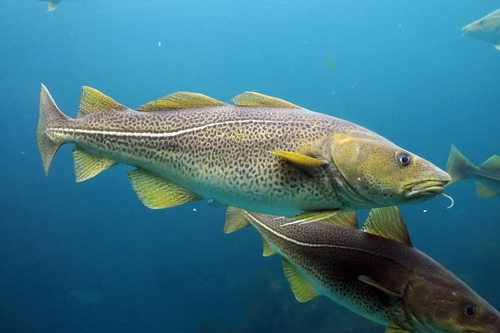
Atlantic Cod
The Atlantic Bluefin Tuna (Thunnus thynnus) is a highly migratory, large pelagic fish renowned for its size, speed, and commercial value. It's a top predator in the marine ecosystem, playing a crucial role in maintaining the balance of ocean life. This species is not only a marvel of nature but also a subject of significant conservation concern.
10 25 years
Lifespan
100 - 140 cm
Length
Vulnerable
Conservation Status
18 km/h
Swimming speed
Carnivorous, Scavengers
Diet
Seasonal Migration, Local Migration
Migration
Appearance Overview
The Atlantic Bluefin Tuna showcases a robust, streamlined body built for speed and endurance.
Color
Dark metallic blue above, silvery white below
Body shape
Torpedo-shaped
Fins
Two dorsal fins, the first depressible; small, yellow finlets running from the second dorsal and anal fins to the tail
Length
Typically up to 10 feet (3 meters), but can reach up to 13 feet (4 meters)
Weight
Commonly up to 550 lbs (250 kg), but can reach over 1,500 lbs (680 kg)
Diet
Carnivorous, feeding on a variety of fish, squid, crustaceans, and occasionally, on plankton and algae.
Feeding Behavior
An opportunistic predator, it uses its speed and agility to hunt. They often hunt cooperatively, corralling and herding prey.
Social Behavior
Highly migratory and known to form schools, sometimes segregated by size. They exhibit complex social behaviors during spawning.
Commercial Relevance
Extremely high value, particularly in the Japanese sushi and sashimi market, where a single fish can fetch hundreds of thousands of dollars.
Conservation measures
Subject to international fishing quotas and regulations, marine protected areas, and efforts to improve fishing gear selectivity.
Status
Endangered
Threats
Overfishing is the primary threat, exacerbated by illegal and unreported fishing. Climate change and habitat degradation also pose risks.
Habitat Distribution
Depth Range
Typically found from the surface to depths of 500-1,000 meters, depending on the season and location.
Geographic Range
Found across the North Atlantic Ocean, including the Mediterranean Sea. Key areas include the Gulf of Mexico, the western and eastern Atlantic, and the Mediterranean.
Preferred Environment
Prefers temperate and subtropical waters. They undertake long migrations across the Atlantic, moving to specific spawning grounds.
Reproduction and Life Cycle
Breeding Habits
Spawns in two main areas: the Gulf of Mexico and the Mediterranean Sea. Spawning occurs in open waters, typically between April and June.
Development Stages
Eggs hatch into larvae, which are planktonic and grow rapidly. Juveniles develop quickly, reaching significant size within their first year.
Fecundity
Highly fecund; a single female can release up to 30 million eggs per spawning season.
Maturity Age
Reaches sexual maturity relatively late, at around 4-8 years of age, depending on the population.
Faqs about Atlantic Cod
Why is Bluefin tuna so expensive?
Bluefin tuna is highly prized, especially in Japan, for its fatty flesh used in sushi and sashimi.
Where can I find Atlantic Bluefin Tuna?
Atlantic Bluefin Tuna are found across the Atlantic Ocean, from the Gulf of Mexico to the Mediterranean Sea.
How long do Bluefin Tuna live?
They can live up to 40 years, though this is becoming increasingly rare due to overfishing.
Can I eat Bluefin Tuna ethically?
Yes, but it must be sourced from sustainably managed fisheries, which are currently rare.
How fast are Bluefin Tuna?
They are among the fastest fish in the ocean, capable of bursts of speed up to 43 mph (70 km/h).
Are Bluefin Tuna warm-blooded?
They are warm-blooded, which is rare among fish. This allows them to maintain a higher body temperature than the surrounding water, aiding in muscle efficiency.
Copyright @ Nature Style Limited. All Rights Reserved.
 English
English